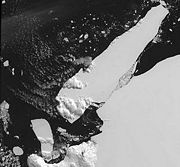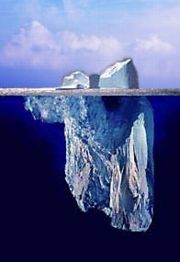Iceberg


An iceberg is a large piece of freshwater ice that has broken off from a snow-formed glacier or ice shelf and is floating in open water.[1]
Contents |
Etymology
The word iceberg is a partial loan translation from Dutch ijsberg, literally meaning ice mountain,[2] cognate to Danish Isbjerg, Swedish Isberg, Low Saxon Iesbarg and German Eisberg
Overview
Because the density of pure ice is about 920 kg/m³, and that of sea water about 1025 kg/m³, typically only one-tenth of the volume of an iceberg is above water. The shape of the remainder under the water can be difficult to surmise from looking at what is visible above the surface. This has led to the expression "tip of the iceberg", generally applied to a problem or difficulty, meaning that the visible trouble is only a small manifestation of a larger problem.
Icebergs generally range from 1 to 75 meters (3–250 ft) above sea level and weigh 100,000 to 200 000 tonnes. The tallest known iceberg in the North Atlantic was 168 meters (550 ft) above sea level, making it the height of a 55-story building. Despite their size, the icebergs of Newfoundland move an average of 17 kilometers a day (10 mi).[3] These icebergs originate from the glaciers of western Greenland, and may have an interior temperature of -15 to -20°C (5 to -4 °F).[4]
Though usually confined by winds and currents to move close to the coast, the largest icebergs recorded are calved, or broken off from, the Ross Ice Shelf of Antarctica. Iceberg B-15, photographed by satellite in 2000, measured 295 km long and 37 km wide (183-23 mi), with a surface area of 11,000 km² (4,250 mi²). The mass was estimated around three billion tonnes.
When an iceberg melts, it makes a fizzing sound called "Bergie Seltzer." This sound is made when compressed air bubbles trapped in the iceberg pop. The bubbles come from air trapped in snow layers that later become glacial ice.[4]
Ice campers who camp on top of flat or hollowed icebergs are known as icebergers.
Classification
Size

This size classification is used by the International Ice Patrol:[5]
| Size Category | Height | Length |
|---|---|---|
| Growler | Less than 1 metre (3 ft) | Less than 5 metres (16 ft) |
| Bergy Bit | 1–4 meters (3–13 ft) | 5–14 meters (15–46 ft) |
| Small | 5–15 meters (14–50 ft) | 15–60 meters (47–200 ft) |
| Medium | 16–45 meters (51–150 ft) | 61–122 meters (201–400 ft) |
| Large | 46–75 meters (151–240 ft) | 123–213 meters (401–670 ft) |
| Very Large | Over 75 meters (240 ft) | Over 213 meters (670 ft) |
Shape
In addition to the above size classification, there is also a type of classification based on shape. The two basic types of iceberg forms are tabular and non-tabular. Tabular icebergs have steep sides and a flat top, much like a plateau, with a length-to-height ratio of more than 5:1.[6] Non-tabular icebergs have different shapes, and include:[7]
- Dome: An iceberg with a rounded top.
- Pinnacle: An iceberg with one or more spires.
- Wedge: An iceberg with a steep edge on one side and a slope on the opposite side.
- Dry-Dock: An iceberg that has eroded to form a slot or channel.
- Blocky: An iceberg with steep, vertical sides and a flat top. It differs from tabular icebergs in that its shape is more like a block than a flat sheet.
History
In the 20th century, several scientific bodies were established to study and monitor the icebergs. The International Ice Patrol, formed in 1914 in response to the Titanic disaster, monitors iceberg dangers near the Grand Banks of Newfoundland and provide the "limits of all known ice" in that vicinity to the maritime community.
A chunk of Antarctic ice about seven times the size of Manhattan suddenly collapsed, putting an even greater portion of glacial ice at risk and an ice shelf about the size of Connecticut was "hanging by a thread" as of March 25 2008.[8][9]
Monitoring

Icebergs are monitored worldwide by the U.S. National Ice Center (NIC), established in 1995, which produces analyses and forecasts of Arctic, Antarctic, Great Lakes and Chesapeake Bay ice conditions. More than 95% of the data used in its sea ice analyses are derived from the remote sensors on polar-orbiting satellites that survey these remote regions of the Earth.
The NIC is the only organization that names and tracks all Antarctic Icebergs. It assigns each iceberg larger than 10 nautical miles (18 km) along at least one axis a name composed of a letter indicating its point of origin and a running number. The letters used are as follows:
- A – longitude 0° to 90° W (Bellingshausen Sea, Weddell Sea)
- B – longitude 90° W to 180° (Amundsen Sea, Eastern Ross Sea)
- C – longitude 90° E to 180° (Western Ross Sea, Wilkes Land)
- D – longitude 0° to 90° E (Amery Ice Shelf, Eastern Weddell Sea)
Iceberg B15, which calved from the Ross Ice Shelf in 2000 and initially had an area of 11,000 km², was the largest iceberg ever recorded. It broke apart in November 2002. The largest remaining piece of it, Iceberg B-15A, with an area of 3,000 km², was still the largest iceberg on Earth until it ran aground and split into several pieces October 27 2005. It has been determined that the cause of the breakup was an ocean swell generated by an Alaskan storm 6 days earlier and 13,500 kilometers (8,370 miles) away.[10]
Technology history

There was no system in place before 1912 to track icebergs to guard against ship collisions. The sinking of the RMS Titanic, which caused the death of more than 1,500 of its 2,223 passengers, created the demand for a system to observe icebergs. For the remainder of the ice season of that year, the United States Navy patrolled the waters and monitored ice flow. In November 1913, the International Conference on the Safety of Life at Sea met in London to devise a more permanent system of observing icebergs. Within three months, the participating maritime nations had formed the International Ice Patrol (IIP). The goal of the IIP was to collect data on meteorology and oceanography in order to measure currents, iceflow, ocean temperature, and salinity levels. They published their first records in 1921, which allowed for a year-by-year comparison of iceberg movement.
New technologies monitor icebergs. Aerial surveillance of the seas in the early 1930s allowed for the development of charter systems that could accurately detail the ocean currents and iceberg locations. In 1945, experiments tested the effectiveness of radar in detecting icebergs. A decade later, oceanographic monitoring outposts were established for the purpose of collecting data; these outposts continue to serve in environmental study. A computer was first installed on a ship for the purpose of oceanographic monitoring in 1964, which allowed for a faster evaluation of data. By the 1970s, icebreaking ships were equipped with automatic transmissions of satellite photographs of ice in Antarctica. Systems for optical satellites had been developed, but were still limited by weather conditions. In the 1980s, drifting buoys were used in Antarctic waters for oceanographic and climate research. They are equipped with sensors that measure ocean temperature and currents. Side-Looking Airborne Radar (SLAR) made it possible to acquire images regardless of weather conditions. On November 4 1995, Canada launched RADARSAT-1. Developed by the Canadian Space Agency, it provides images of Earth for both scientific and commercial purposes. This system was the first to use Synthetic Aperture Radar (SAR), which sends microwave energy to the ocean surface and records the reflections to track icebergs. The European Space Agency launched ENVISAT on March 1 2002, an environmental satellite which uses Advanced Synthetic Aperture Radar (ASAR). This can detect changes in surface height accurately. The Canadian Space Agency launched RADARSAT-2 in December 2007, which uses SAR and multipolarization modes and follows the same orbit path as RADARSAT-1.[11]
References
- ↑ Numerous definitions of the word "Iceberg" URL accessed December 20, 2006.
- ↑ Online Etymology Dictionary. iceberg. URL accessed March 29, 2006.
- ↑ http://www.wordplay.com/tourism/icebergs/ URL accessed June 16, 2007
- ↑ 4.0 4.1 Canadian Geographic Facts on Icebergs URL accessed December 20, 2006.
- ↑ Iceberg FAQ URL accessed December 20, 2006.
- ↑ Clarification on the Sizes and Shapes of Icebergs URL accessed December 20, 2006.
- ↑ Iceberg Physiology URL accessed December 20, 2006
- ↑ CNN (2008-03-25). "Huge Antarctic ice chunk collapses". CNN. Retrieved on 2008-03-25.
- ↑ CNN (2008-03-25). "Massive ice shelf on verge of breakup". CNN. Retrieved on 2008-03-26.
- ↑ Alaskan storm cracks giant iceberg to pieces in faraway Antarctica
- ↑ Canadian Geographic. Tracking Monsters. URL accessed March 29, 2006.
External links
- Iceberg Finder Service for east coast of Canada
- Icebergs of The Arctic and Antarctic
- Iceberg Google maps - South Georgia
- Glide through Iceberg Alley Best of flickr, youtube video wall, interactive map and references.